| Route 8 |
| 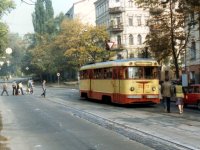 | On 26 May 1985, a Kiev Day weekend, citizens were
served a "gift" — tram route 30 "Vokzal — Pechersky Most" was shut down.
The reason was a stub terminus at Pechersky most, whose presence required double-ended cars.
Those had not been manufactured for more than 15 years, and therefore all of them were aging relentlessly.
After that closure, a single stub-ended route remained — No. 8, which connected
the neighborhood of Solomenka with the university.
In this picture, car 2073 is approaching Ulitsa Saksaganskogo.
In the background is Ulitsa Tolstogo, which approaches the lower entrance
to the Botanical Garden and then makes a slight right turn and starts to ascend.
[Gordon Stewart, 06.10.1985] |
|
| 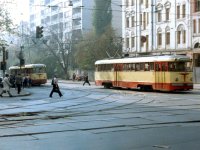 | A picture taken from the opposing viewpoint.
Two cars on route 8 are approaching each other. 2074 completes its crossing
of Saksaganskogo, while 2076 makes a scheduled stop short of the crossroads.
In the foreground one can see the tram line on Saksaganskogo and two service tracks,
which form the only connection of route 8 with the rest of the network.
Later on, these would be used for route 8-K, subsequently numbered 5,
and then for all routes in this area, as part of the Saksaganskogo line would be dismantled.
Today, no trams run here at all.
[Gordon Stewart, 06.10.1985] |
|
| 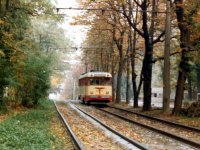 | On this and the next picture, one can see a reservation track
along Ulitsa Tolstogo, which ran uphill along the Botanical Garden fence.
Car 2019 is completing its run up to the University.
As the poet Alexander Chernov put it, "Reflected in the glass of the back window //
Are the Botanical Garden and the middle of autumn"...
To the right from the tracks there are some construction supplies — concrete blocks,
pipes, wooden fence. Most probably, hot water or sewer pipes are being repaired.
[Gordon Stewart, 07.10.1985] |
|
| 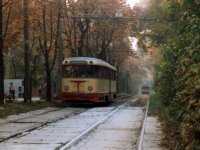 | The same spot viewed from the opposite direction.
In the foreground is car 2056, having almost completed its ascend;
in the background, another one at about the middle of its downhill run.
Barely visible at the top is a sign which reads "DOWNHILL. SPEED LIMIT 10 km/h".
According to that prescription, the old cars would go down slowly and carefully,
making several technical stops along the way (those were marked with similar-looking signs).
On the contrary, going uphill, they did so at full speed, wheels rattling.
[Gordon Stewart, 07.10.1985] |
|
| 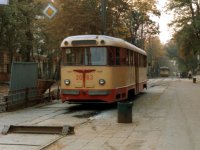 | The reservation track along Tolstogo ended at
University, where a stub terminus was set up in 1959.
That is where this and the next picture were taken.
Here, car 2063 is about to reverse, move to its initial stop,
and accept new passengers, which can be seen on the right.
Another car is on approach, about to disembark its passengers at the end
of the journey.
In the foreground one can clearly see the safety rail, laid across the track.
That was done after an accident which happened here in the 1970s,
when a tram failed to brake and hit a concrete wall which used to stand right after the stub.
[Gordon Stewart, 07.10.1985] |
|
| 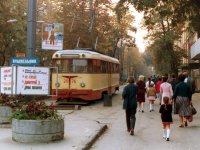 | Instead of the aforementioned wall, there is a flower bed
and an advertisement board for the Budivelnik cinema,
which was situated at the next stop of this tram route.
Attached to the lamp pole is a pedagogical billboard, explaining the rules
of the road to children. (Commercial advertisement in the USSR? Forget it!)
Route 8 was closed permanently on 15 December 1987.
In the next few years, the tracks were dismantled, and in slightly less than a decade,
the former tram line was turned into a roadway. Thus, cars run here nowadays.
[Gordon Stewart, 07.10.1985] |
|
| Saksaganskogo — Ploschad Pobedy — Lvovskaya Ploschad |
| 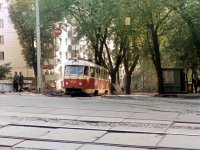 | This Tatra T3 car is running at quite a speed:
it has just rushed up Vladimirskaya and is about to turn onto Saksaganskogo,
almost without slowing down.
In the background on the right there is another T3, crawling down carefully.
At the turn of the millennium, trams would gradually leave this place:
1996, route 9 shut down; 1997, passenger service suspended, for fear of the steep incline;
2001, all tram service on Saksaganskogo terminated, leaving only the service tracks to the depot;
2005, the depot moved to the suburb of Borschagovka, followed by the removal of the tracks...
[Gordon Stewart, 05.10.1985] |
|
| 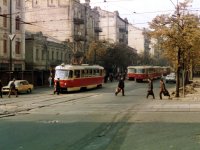 | Once again, the intersection of Saksaganskogo and Tolstogo.
The former street (the one going away from us and right) was one of the main
tram thoroughfares in Kiev, as it connected the railway station and Podol
with Bessarabka and Pechersk. That is why many services always ran here
— up until complete suspension in 2001.
That is clearly visible in this picture, with two trainsets and two single cars
in one frame.
[Gordon Stewart, 05.10.1985] |
|
| 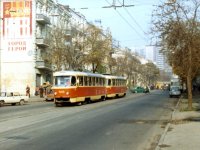 | A trainset of two cars from the Darnitsa Depot,
on route 35 bound for Vokzal (railway station), is depicted on Ulitsa Kominterna,
between Saksaganskogo and Zhadanovskogo (Zhilyanskaya).
Kominterna was the last stretch for the routes which terminated at Vokzal.
This line was shut down and dismantled in 1996, because of a
reconfiguration of the tram network in this neighborhood.
The only kinds of mass transit here nowadays are trolleybuses and buses.
[Gordon Stewart, 06.10.1985] |
|
| 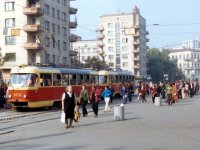 | A trainset of two brand-new Tatras, just delivered to
the Lukyanovka (Lenin) depot, is at the Ploschad Pobedy stop, Vokzal-bound.
Tram tracks as well as this very stop do remain here nowadays,
but chaos pretty much reigns, as there is a permanent crowd, many
retail kiosks... and, to be sure, automobiles, which could not care less
about the pedestrian-only restriction.
Occasionally, they actually park right at the tram stop...
[Gordon Stewart, 06.10.1985] |
|
| 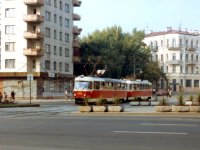 | This and the next pictures were taken at the
spot where the tram tracks cross the roadway of Bulvar Shevchenko,
which changes its name into Prospekt Pobedy (Victory Avenue) right here.
This trainset is also Vokzal-bound. Rather little has changed here today,
except that, once again, there are many more cars.
Additional traffic lights have been installed in an attempt to improve traffic
management — but that did not help much. In fact, at times of
traffic jams, the effect of those lights is actually negative.
[Gordon Stewart, 06.10.1985] |
|
| 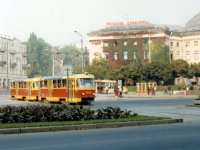 | The same spot viewed from a different direction.
The trainset headed by 5828 is, again, bound for Vokzal.
The building in the background is the circus, erected in 1960.
The current performance is a program by a Riga-based company.
[Gordon Stewart, 06.10.1985] |
|
| 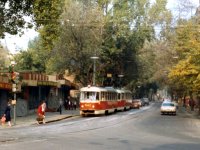 | Northwest of Ploschad Pobedy, at the intersection
of Vorovskogo and Dmitrievskaya (Menzhinskogo back then),
until 1996 there was a branching of tram tracks.
Route 2 proceeded straight and up along Vorovskogo, towards Lvovskaya Ploschad;
the line towards Lukyanovka, which still exists, turned left.
In this picture one sees the Vorovskogo line.
On the left are a few shabby barns, one of them bearing a sign
"Shoe repair".
Judging by their state and by the wooden fence sections
between them, their days are counted.
Note that there is a queue of several cars behind the tram.
[Gordon Stewart, 06.10.1985] |
|
| 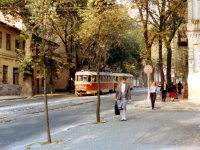 | The same line, a block higher, at the intersection
with Turgenevskaya. Another Tatra trainset (the head car is 5822)
goes in the opposite direction.
A wooden lamp pole at the corner bears a road sign
"Do not enter", popularly known as "the brick".
[Gordon Stewart, 06.10.1985] |
|
| 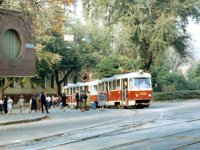 | The last picture from this series:
the Lvovskaya Ploschad terminus of routes 2 and 15.
On the left is a solid brick building in the then-fashionable "cosmic" style,
housing the dispatcher's office.
Up until 1959, the line continued from here, turning onto Yaroslavov Val and
then on Vladmirskaya; a visible trace of that configuration is the layup track
(joining the turning loop from the right).
In 1991, route 15 was redirected from here to the new terminus at Starovokzalnaya.
In August 1996, route 2 was closed, whereupon the Vorovskogo line was dismantled.
[Gordon Stewart, 06.10.1985] |
|
| The speed tram line and around |
| 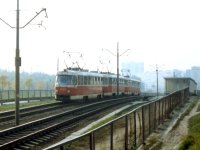 | The Kiev speed tram (light rail) line, inaugurated in 1978,
became the first one in the Soviet Union.
From the very first days, the brand-new Tatrs cars from the Shevchenko depot
serviced that line. In this picture, a three-car set 6005+6006+6007
is next to the Vozduhoflotskaya station, bound for Dvorets Sporta on route 1.
Back then, that route connected the new residential area of Yuzhnaya Borschagovka
with downtown Kiev (its downtown section does not exist any longer).
[Gordon Stewart, 06.10.1985] |
|
| 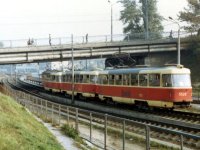 | A glance from the same spot in the opposite direction.
The three-car train 5527+5528+5529 is also bound for Ulitsa Saksaganskogo and the downtown,
along route 1, passing under Vozduhoflotsky Most (bridge).
This place has not changed much since then, except that there are
more cars and less order...
[Gordon Stewart, 06.10.1985] |
|
| 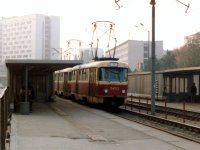 | Approaching the Polevaya station is a train headed by 5453,
on route 3, which was 100% on reservation track.
Rather few cars on the roadway (just a white Lada and a Volga taxi are visible),
and not too many people waiting at the stop, either.
Behind the tram are the buldings and dormitories of the Kiev Polytechnical Institute,
which was founded in 1898.
[Gordon Stewart, 07.10.1985] |
|
| 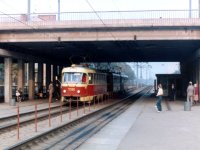 | Another three-car set is on route 3, bound for its outer terminus
at Koltsevaya Doroga. The Bulvar Ivana Lepse station is right under the viaduct
which the boulevard in question runs over.
Beneath the viaduct is Prospekt Kosmonavta Komarova, the continuation of
Borschagovskaya Ulitsa, whose center is the speed tram line itself.
As of this writing (January 2008), the tram does work, but the "speed" qualifier
can hardly be applied to it... However, a capital reconstruction of the line is in progress.
[Gordon Stewart, 07.10.1985] |
|
| 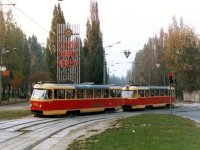 | This was what one could see upon climbing the viaduct depicted
on the previous photo. There is another tram line, with routes 14 and 15,
which is also in service today.
A two-car train 5705+5702 is on route 14, bound for the Avtogenny Zavod terminus.
The cars are clearly seen to be quite new and shiny.
Again, the spot has not changed much, except that the Soviet symbols
have been traded for an affluence of rubber-tyred vehicles.
[Gordon Stewart, 07.10.1985] |
|
| 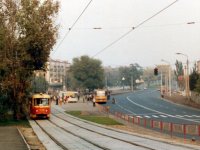 | Ulitsa Vatchenko (nowadays Vasilenko) at Metro Beresteyskaya
(back then, Zhovtnevaya). This train is also bound for Avtogenny Zavod, on route 14.
In the background one can see a fresh Ikarus 260 approaching a bus stop, on route 9.
Even further away, behind the concrete lamp poles, is an older LiAZ 677 bus.
That bus route still exists today (it has been extended to Lukyanovka),
but neither of those two bus types can be seen servicing it now.
[Gordon Stewart, 07.10.1985] |
|
| 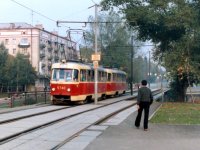 | A two-car train headed by 5740 is bound for the same Avtogenny Zavod,
on route 15. The train completes its crossing of Prospekt Pobedy over a bridge.
The sign installed on the steel wire support pole reads:
"No walking on tram tracks"; however, at least two people are just about
to disregard the restriction...
[Gordon Stewart, 07.10.1985] |
|